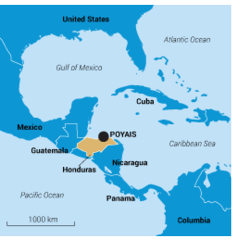Centered in London, the banking panic of 1825 has been called the first modern financial crisis, the first Latin American crisis, and the first emerging market crisis. And while the panic displayed many of the key elements of past crises we have covered—fluctuations in money growth, an investment bubble, a stock market crash, and bank runs—this crisis had its own twists, including a Bank of England that hesitated before stepping in as lender of last resort. But it is perhaps best known for an infamous bond market swindle surrounding an entirely made-up Central American principality. In this edition of Crisis Chronicles, we explore the Panic of 1825 and visit the mythical nation of Poyais.
The Boom
With the end of the Napoleonic Wars in 1815, the Bank of England embarked on a tight monetary policy to resume specie convertibility at the pre-1797 parity (Neal 1998, Bordo 1998). The resulting deflation, apparently unanticipated, had its usual pernicious effect of increasing real debt burdens, but it nevertheless led to successful resumption of convertibility in May 1821. At that point, monetary policy started to become more expansionary. In Neal’s telling, liquidity was flowing from three sources. First, the Treasury was conducting a version of market operations by issuing Exchequer bills to the Bank, then using credits at the Bank to retire high-interest long-term bonds held by the public. Second, the Bank, with plentiful gold reserves accumulated in the drive to convertibility, was running traditional open market operations by buying up war bonds from the public in exchange for cash. Lastly, with the monetary base increasing, country banks—small banks located outside of London—were issuing notes in the hinterland to finance investment in infrastructure, such as gas lighting, canals, and railroads, as well as stock market speculation (Bordo).
The Latin American/Emerging Market Connection
As Spain lost control of its South American interests, several independent nations emerged, including Chile, Colombia, Argentina, Peru, Mexico, and Guatemala. These fledging nations were eager to develop infrastructure, as well as exploit their mineral resources, and their needs created a huge demand for funds and technical expertise from the financial centers in Europe, particularly London, which had replaced Amsterdam as the financial capital of Europe. The sovereign bonds issued by these emerging nations, despite the nations’ lack of the tax structure needed to repay the debt, were all the rage in the early 1820s. English mining firms entered the fray as well by forming joint stock companies devoted to developing South American mineral interests. The share price of one such company, Anglo Mexican, rose from £33 to £158 in a single month (The Economist).
The underwriting of these emerging market securities was not always rigorous. Neal blames this on investors’ “reach for yield” after returns on safe British Consols declined substantially following the end of the war, and on the inherent difficulty of assessing risk at such long distances. Even with favorable winds, a round trip from South America to London took six months, so new information was both slow and scarce.
“New Securities Promiscuously Floated . . .” (Gayer, Rostow, and Schwartz 1953)

As happens, the lax underwriting, poor information, and general speculative fever invited fraud. The starkest example was Gregor MacGregor, a Scottish adventurer who had fought for Venezuela in its war of independence against Spain. Upon his return to England, MacGregor toured the wealthiest drawing rooms of London touting the vast resources, civil service, and army of the entirely fictional Central American principality of Poyais (see map above). So convincing was MacGregor that he was able to float a large bond issue on the London Stock Exchange in 1822. As evidence of the information gaps during the bubble, Neal notes that mythical Poyais was able to borrow at yields barely higher than those charged real countries like Peru, Chile, and Colombia.
The Bust and a Central Bank Misstep
Unlike the Crisis of 1816, the London stock and bond market crash in April 1825 that brought on the panic does not seem traceable to a single exogenous shock, such as a crop failure. Even in their exhaustive, two-volume The Growth and Fluctuation of the British Economy 1790-1850, Gayer, Rostow, and Schwartz (1953, p. 171), merely state that “In the spring of 1825, a turning point came . . .” without saying exactly what turned. Bordo notes that, in March, the Bank sold a considerable sum of Exchequer bills, which contracted the monetary base and may have contributed to the crash. Or perhaps, he suggests, it was a sunspot. Whatever the precise trigger, the crash caused “commercial failures” (Bordo) and a “drop in collateral values” (Neal) that slowed activity over the ensuing months. By summer of that year, the price of Latin American bonds had fallen by half. Banks were highly exposed to such debt, so their nervous depositors began to withdraw. By December, there were outright runs, and as the panic spilled into 1826, fully 10 percent of the banks in Wales and England failed (The Economist). As the money and credit supply contracted, bankruptcies and unemployment soared while production slumped.
The crisis was aggravated by the Bank of England’s initial failure to act as lender of last resort. To ensure that it would not have to suspend convertibility or risk profits, the Bank actually raised the discount rate in December 1825, in the midst of a bank run! Only after some large London banks failed, including Henry Thornton’s, did the Bank finally begin increasing its advances to struggling City and country banks.
Bagehot (1891) later chastised the Bank for initially “acting as unwisely as it is possible to act,” and used its initial misstep as a case for what a lender of last resort should not do. However, he approvingly quoted the statement by Jeremiah Harman, the Bank of England Director during the crisis, about the Bank’s eventual decision to step up:
We lent . . . by every means possible and in modes we had never adopted before; we took stock on security, purchased Exchequer bills, we made advances on Exchequer bills, we not only discounted outright, but we made advances on deposits of bills of exchange to an immense amount, in short, by every possible means consistent with the safety of the bank . . .
Modern Parallels?
It seems that the Bank eventually threw everything it had at the Panic of 1825. Does that sound familiar? The Term Auction Facility, the Commercial Paper Funding Facility, the Money Market Investor Funding Facility, and the Term Asset-Backed Securities Loan Facility are just a few of the liquidity programs that the Federal Reserve used to stem the Panic of 2008.
This 2009 blog post draws some parallels between 1825 and 2008 based on the information asymmetries that plagued the securities markets in both cases—bonds issued by far-off, fledging nations in the former case and exotic asset-backed securities in the latter. Are there other parallels between the panics of 1825 and 2008? Let us know what you think.
Disclaimer
The views expressed in this post are those of the authors and do not necessarily reflect the position of the Federal Reserve Bank of New York or the Federal Reserve System. Any errors or omissions are the responsibility of the authors.

Donald P. Morgan is an assistant vice president in the Federal Reserve Bank of New York’s Research and Statistics Group.
James Narron is a senior vice president in the Federal Reserve Bank of San Francisco’s Cash Product Office.











 RSS Feed
RSS Feed Follow Liberty Street Economics
Follow Liberty Street Economics
Great analysis…” the London stock and bond market crash in April 1825″ had a precedent in the South Sea Company of 1720 whose debt was paid off in 2015 (after consolidations of Consols in 1853 and 1932).
Seems to have started with control fraud in both cases. Loans against fictitious assets (be it stated property or stated income). Did the banks back then also “bundle” these bonds and sell them as high grade securities? When they started failing to produce returns and their value as an asset collapsed, the market felt pinched and acted accordingly, cutting back and proceeding to batten down the hatches. It seems that “trickles down” a lot faster than any “wealth effect” ever did. Consider too, the effects of fiscal policy: http://research.stlouisfed.org/fred2/graph/?id=FYFRGDA188S Notice the rise in revenue often precedes a recession. Not to hard to imagine, you take away more of what consumers use to consume, some output doesn’t get sold unless consumers leverage up. That’s a bit of a precarious position, and if things start to go awry, we will have a pro-cyclical decline that stretches from the bottom to the top income brackets. Monetary policy can only do so much. You can lead them to water…
As a young man Benjamin Disraeli was wiped out in the 1825 crash and left with thousands of pounds in debt. He spent much of his time for many years trying to deal with this burden (it was likely a spur to his entry into politics: as readers of Victorian fiction know, in those days membership in the House of Commons, while unpaid, had the perk of freedom from being tossed into debtor’s prison by your creditors).